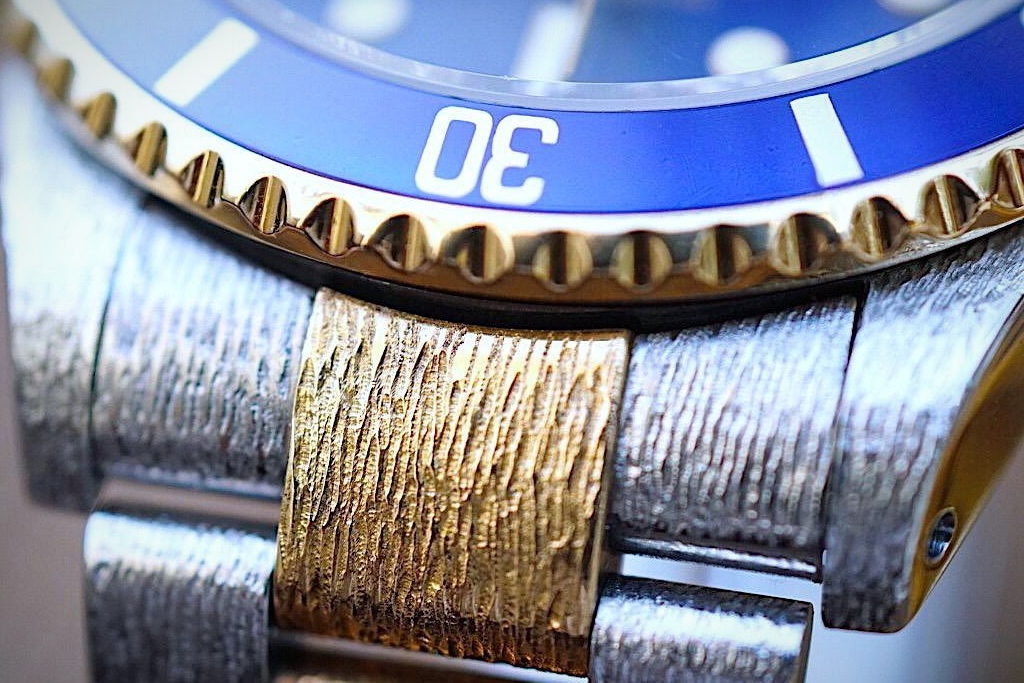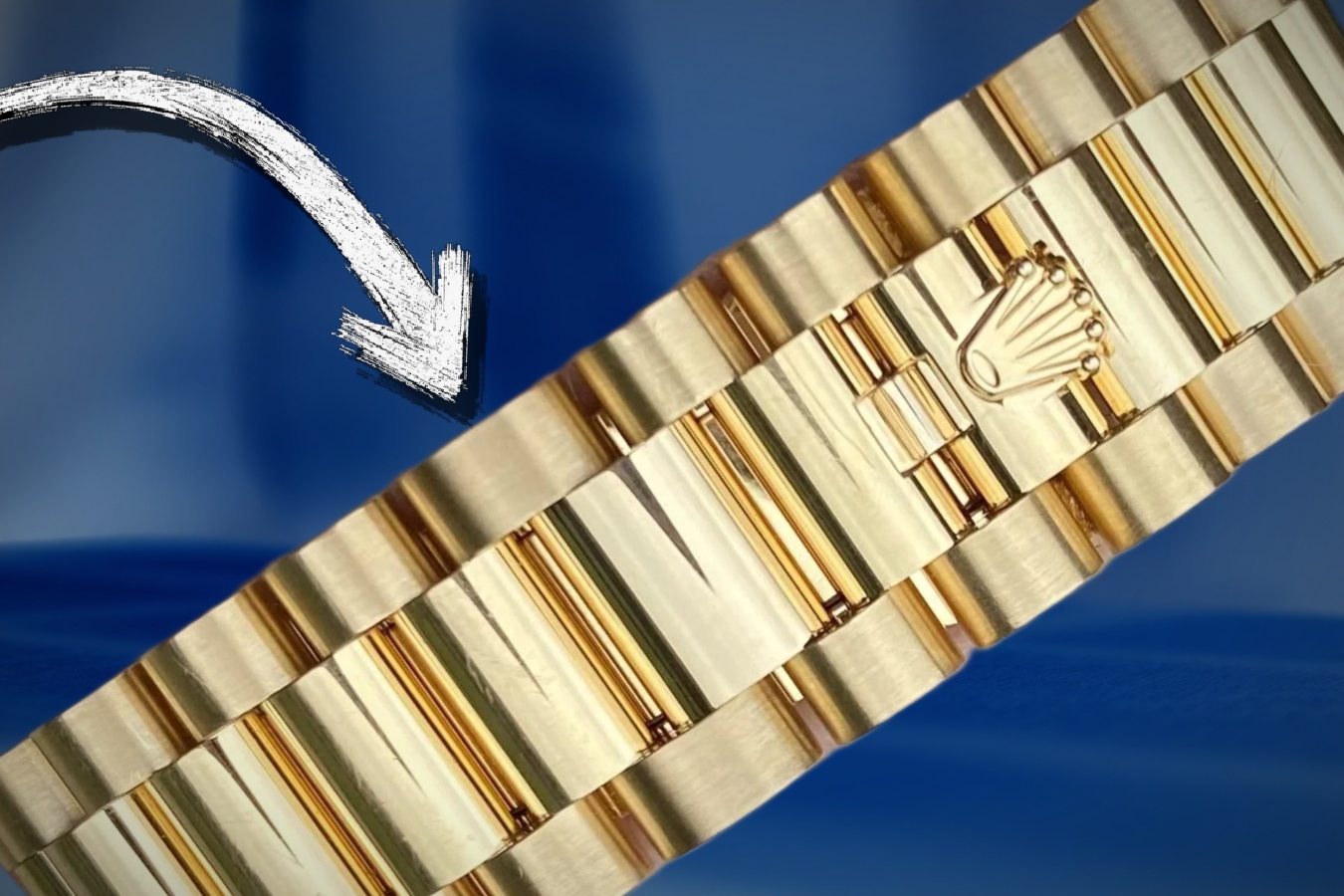The Ultimate Omega Speedmaster White Dial Guide
Since 1957, Omega has been releasing innumerable variations of their popular Speedmaster chronograph watch in several different sizes, styles and colors. But there are relatively few Omega Speedmaster white dial options, especially if you don’t count Omega’s many white-ish silver dials. Here’s our guide to every white Omega Speedmaster reference.
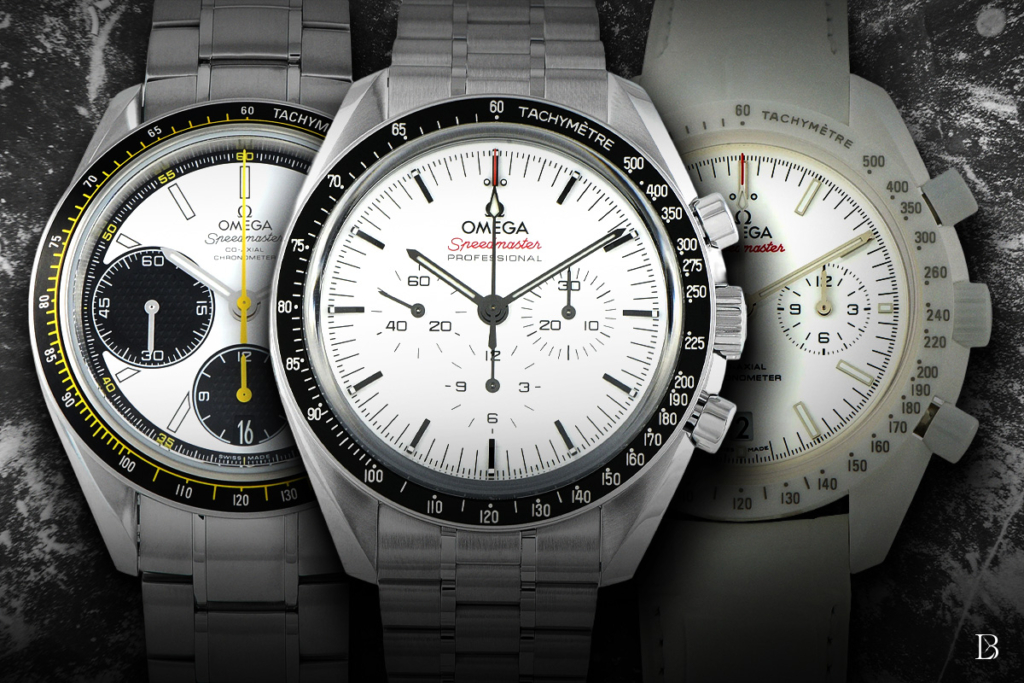
Omega Speedmasters with white dials have been made in six different sizes: 38mm, 39mm, 40mm, 41.5mm, 42mm, and 44.25mm. Except for a few 39mm variants, all of them have sapphire crystals. We’ll start with the ever-popular manual-wind Professional models, also known as “Moonwatch” models because of their extensive space-related history. Then we’ll work our way through the other styles largest-to-smallest.
Speedmaster Professional (42mm)
All Speedmaster Professional a.k.a. “Speedy Pro” models have hand-wound movements and a 42mm diameter. Omega was making them for decades before they ever tried putting a white dial on one.
Italian Albino Speedmaster (1997)
The first Omega Speedmaster Professional with a white dial appeared in 1997, celebrating the 40th anniversary of the Speedmaster. It was only sold in Italy. Rather than a crisp white color, this so-called “Italian Albino” Speedmaster was given a rich creamy dial.
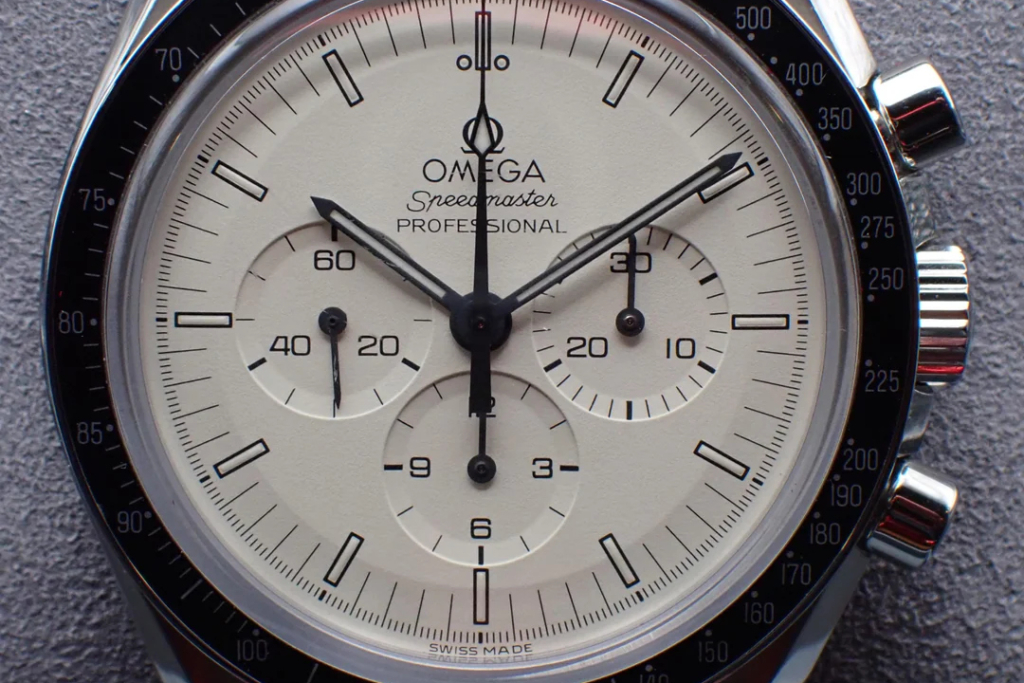
The Italian Albino was the first “sapphire sandwich” Speedmaster–meaning it has a sapphire crystal as well as a sapphire exhibition caseback. Only 500 were made, and they can easily go for over $20,000 today. They were among the first Speedies to have Super-LumiNova rather than tritium lume.
Broad Arrow Moonphase (2000)
Arguably the coolest white-dial Omega Speedmaster of all appeared in 2000. Despite its unusual four-register layout, it is in fact a Professional model. The 12 o’clock subdial contains both a moonphase and a pointer date indicator, which can both be adjusted with the little corrector buttons near 10 o’clock on the case. The blued hands and hour markers are outstanding.
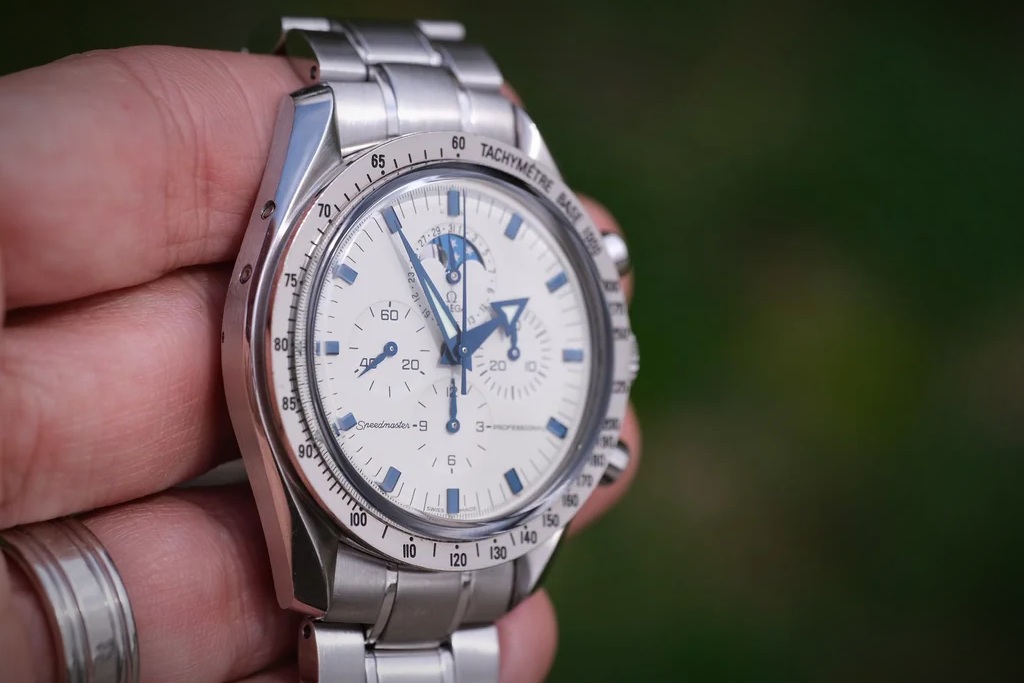
This model (ref. 3875.20.37 on a strap and 3575.20.00 on a bracelet) is one of the most desirable neo-vintage Broad Arrow Speedmasters, and it can be found for under $7,000 despite having a solid white gold bezel. The term “Broad Arrow” in the Omega world refers to any model with hands that resemble those of the very first CK2915 Speedmaster. The hour hand does in fact look like a big arrow; basically they’re dauphine hands where the hour hand has an additional triangle at its tip.

Four-register models like this were given the Omega caliber 1866 movement, which is a hand-wound, Lemania-based movement. Essentially it adds a moonphase and date complication to the familiar workhorse caliber 1861 chronograph movement. Aside from the latest white Speedy Pro, which has the Master Chronometer-certified 3861 movement, every other Professional model in this article is powered by the 1861.
Apollo 11 35th Anniversary (2004)
A Speedmaster Professional with a white dial and black subdials (known as a “panda dial”) appeared in 2004 to celebrate the 35th anniversary of the Apollo 11 moon mission. “July 20, 1969” is written in red, and the caseback features imagery of a bald eagle on the moon.
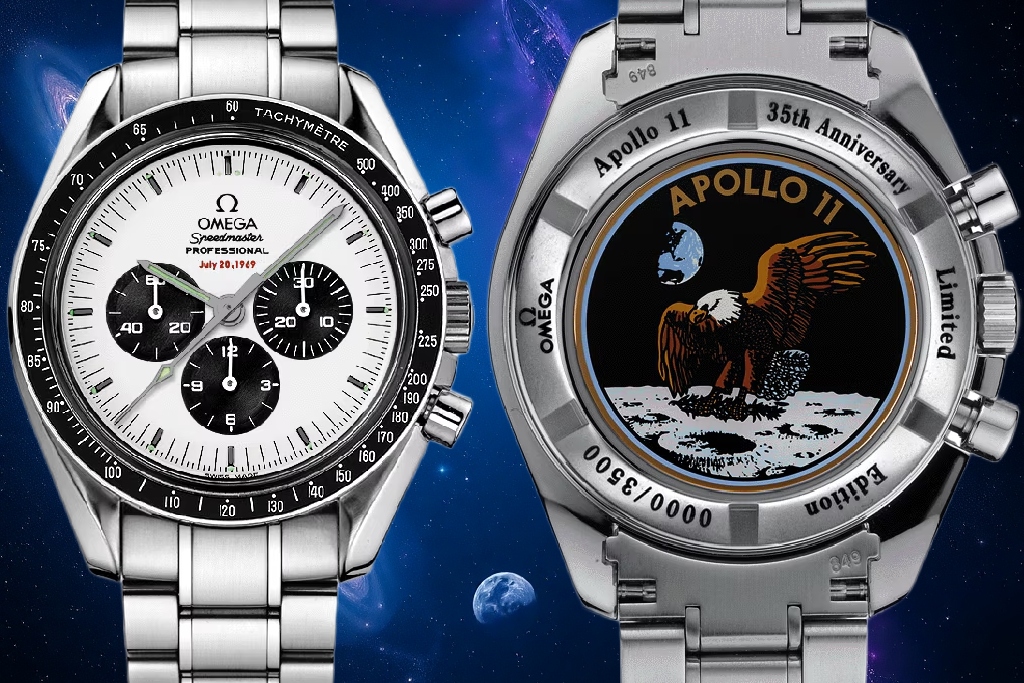
3,500 were produced, which is a lot for a “limited edition,” so you can typically find these 35th anniversary Apollo 11 Speedmasters for under $10,000.
More on the Omega Speedmaster:

Alaska Project (2008)
The first Omega Speedmaster Professional with a “plain” black-on-white dial–not off-white, no dark subdials, no blue hour markers, and no Snoopy imagery–is an unusual one. The first things you’ll probably notice about the Omega Speedmaster Professional Alaska Project, which debuted in 2008, are the weird rocket-like chronograph minute and hour hands.
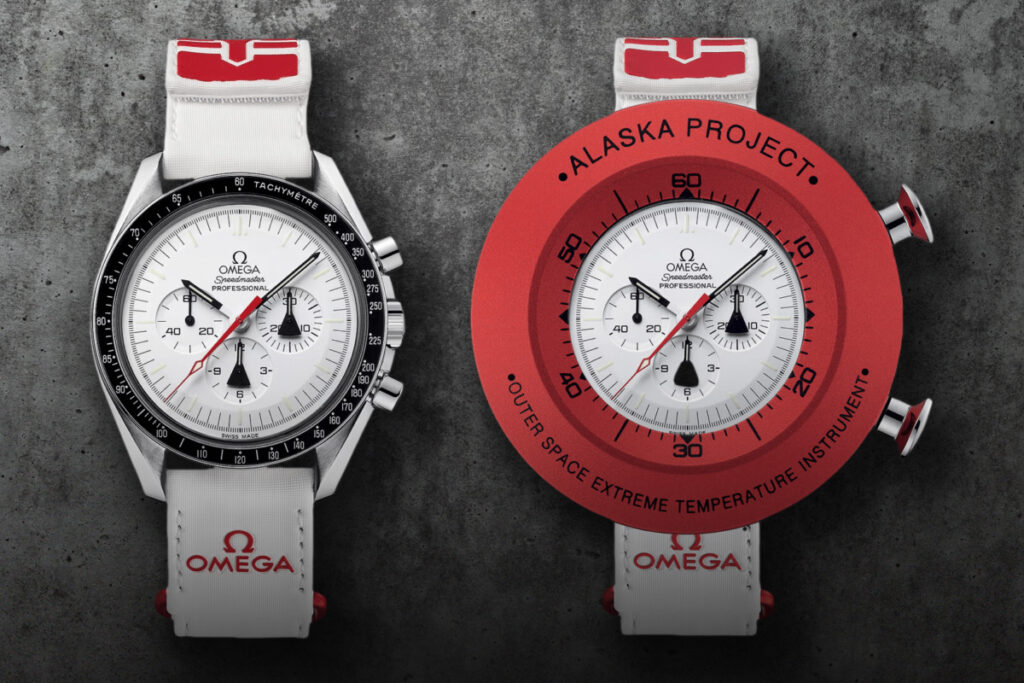
Those hands, designed to maximize legibility in poor lighting conditions, were first seen on the Alaska I, which was the first of three generations of “Alaska Project” Speedmaster prototypes that Omega made for NASA from 1969-1977.
Although those “Alaska Project” prototypes never reached production, the 2008 limited edition of the same name captures the essence of the Alaska I–even including a big red aluminum thermal shield that can go over the whole watch to protect it from the ludicrous temperatures of space. The white Velcro strap is a nice spacesuit-ready touch as well.
White Snoopy Speedmaster (2015)
In 2015, the popular “white Snoopy” Speedmaster debuted celebrating the 45th anniversary of the troubled (but miraculously non-fatal) Apollo 13 mission. Although Omega’s relationship with Snoopy goes back decades, this was only the second Omega Snoopy Speedmaster with Snoopy actually on the dial. It exclusively came on a black coated nylon fabric strap with white stitching and a deployant clasp.
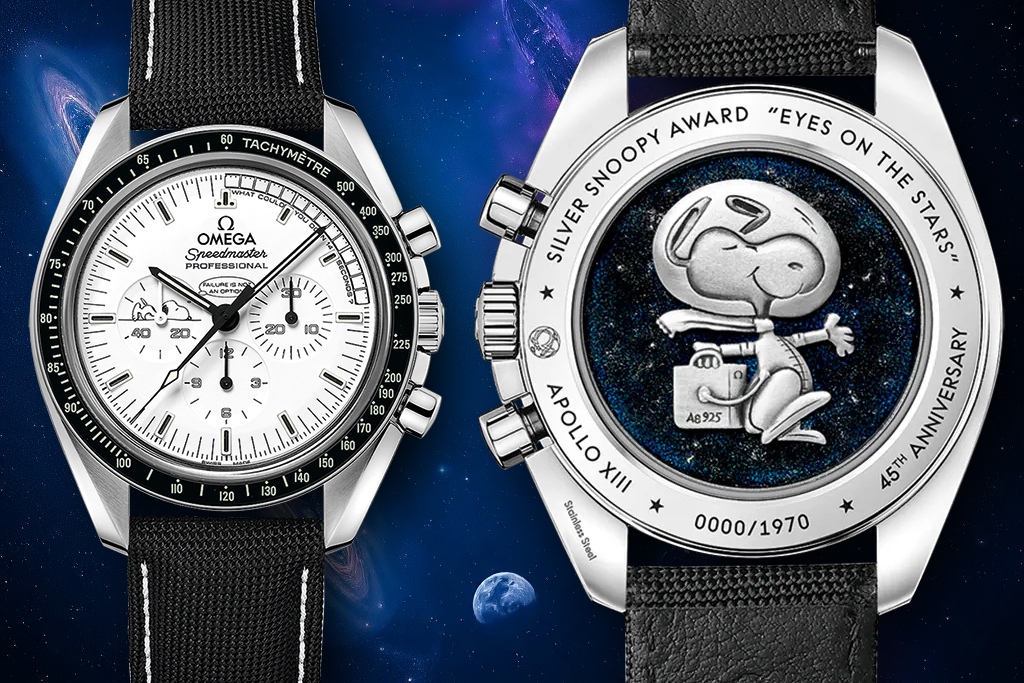
The black hands and hour markers on the White Snoopy are a nice touch, and the words “Failure is not an option” and “What could you do in 14 seconds?” are an homage to the Apollo 13 astronauts’ usage of a Speedmaster to time a critical 14-second reentry burn. Only 1,970 were made, and collectors love them, so you can expect to pay over $40,000 if you find one.
Moonwatch in White (2023)
The first regular production white-dial Omega Speedmaster Professional went on sale in 2024, after having first been seen on actor and Omega ambassador Daniel Craig’s wrist in 2023. It has the latest Omega features like a Master Chronometer movement, and its list price is $8,700 on a rubber or leather strap–$100 more than the comparable current black sapphire sandwich Speedmaster. The stainless steel bracelet adds $400.
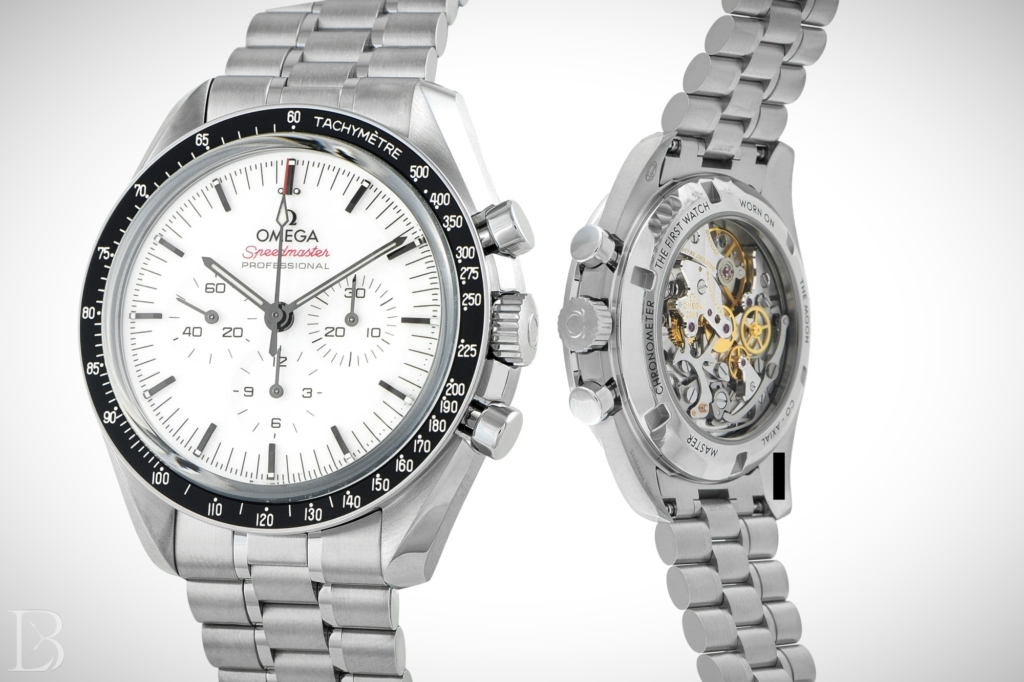
I excluded both the famous Mitsukoshi and the Tokyo 2020 Speedmaster from my list of white-dial Omega Speedmaster Professionals despite their light-colored panda dials, because Omega calls them silver rather than white. It can be confusing because there are also darker silver dials, which Omega simply calls “grey.” Now here’s a condensed list of all the white Omega Speedmaster Professional models. Note that they’re all stainless steel.
All Omega Speedmaster Professional White Dial Models
| Name | Reference Numbers | Details | Year Debuted |
|---|---|---|---|
| Italian Albino | 345.818, 3593.20 (bracelet), 3893.20 (strap) | Cream dial, Italy exclusive, first sapphire sandwich, limited to 500 pieces | 1997 |
| Broad Arrow Moonphase | 3575.20.00 (bracelet), 3875.20.37 (strap) | Blue hands, moonphase, creamy white dial, white gold bezel | 2000 |
| Apollo 11 35th Anniversary | 3569.31.00 | Panda dial (white with black subdials), “July 20, 1969” written in red | 2004 |
| Alaska Project | 311.32.42.30.04.001 | White dial with rocket-shaped subdial hands, comes with big red aluminum thermal shield (over-case), based on a prototype made for NASA | 2008 |
| White Snoopy (Apollo 13 45th Anniversary) | 311.32.42.30.04.003 | White dial with Snoopy imagery in 9 o’clock subdial, along with “Failure is not an option” and “What could you do in 14 seconds?” text | 2015 |
| Moonwatch in White | 310.30.42.50.04.001 (bracelet), 310.32.42.50.04.001 (rubber), 310.32.42.50.04.002 (leather) | White dial, red “Speedmaster” text, “sapphire sandwich” model (meaning a sapphire crystal on the front and back) | 2023 |
44.25mm Co-Axial Omega Speedmaster White Dial Models
Four white-dial Omega Speedmasters have been made with co-axial movements, 6 o’clock date windows, and 44.25mm cases. Every single Omega Speedmaster larger than 42mm has an exhibition caseback.
White Side of the Moon (2015)
The most well-known white 44.25mm Speedmaster is the White Side of the Moon, Omega’s first and only watch to be made of white ceramic. It debuted in 2015, two years after the original Omega Speedmaster Dark Side of the Moon was released in black ceramic.
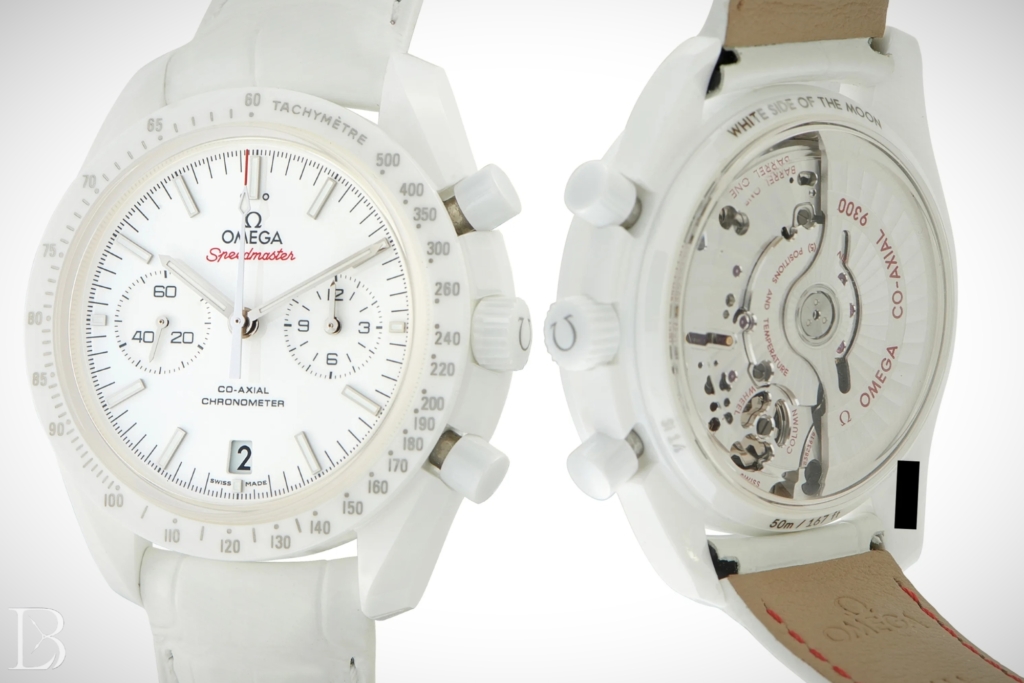
The “WSOTM” was available with a mother-of-pearl dial and a diamond bezel, but the regular version with a white dial and ceramic bezel unsurprisingly sold much better. The white ceramic crown and pushers, along with the white leather strap, complete the aggressive white-on-white aesthetic. Like most of Omega’s chronographs of this size, it has two registers and a date at 6 o’clock.
Speedmaster Broad Arrow Co-Axial GMT (2007)
Two beefy and unusual co-axial 44.25mm Speedmaster Broad Arrow models have been made with white dials. They debuted in 2007 and, well, that’s exactly when they look like they were made.
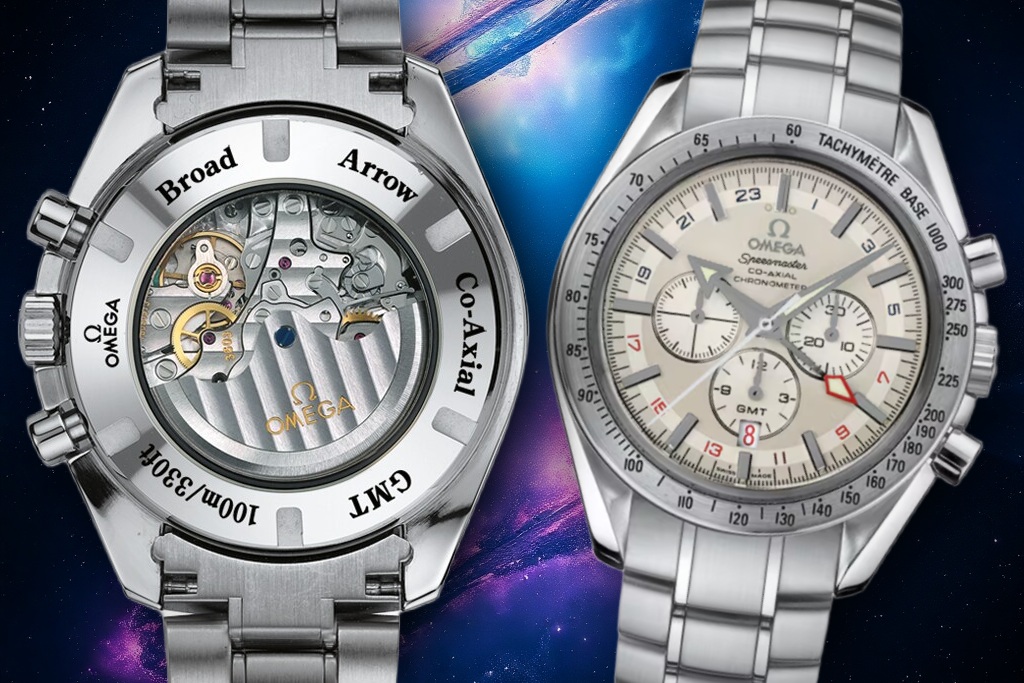
One is ref. 3581.30.00, a regular production co-axial model. It’s one of few Speedmasters with a GMT function, and also one of few with a screwdown crown. Its dial is more “off-white” than white, but Omega calls it white nonetheless. Powered by the F. Piguet 1285 caliber, this is a flyback chronograph. That means if the chronograph is running, you can simply hit the start button again to restart it–no need to stop and reset.
Speedmaster Broad Arrow Co-Axial Rattrapante (2007)
A split-seconds chronograph (rattrapante) Speedmaster with a panda dial was released at the same time as the GMT above. When the chronograph is running, pressing the 10 o’clock pusher stops one of the two centrally-mounted chronograph seconds hands, allowing you to record a split time while the main chronograph hand keeps running. Pressing the same pusher again causes the stopped hand to “catch up” with the moving one, and thus you can continue to stop and record more split times as needed.
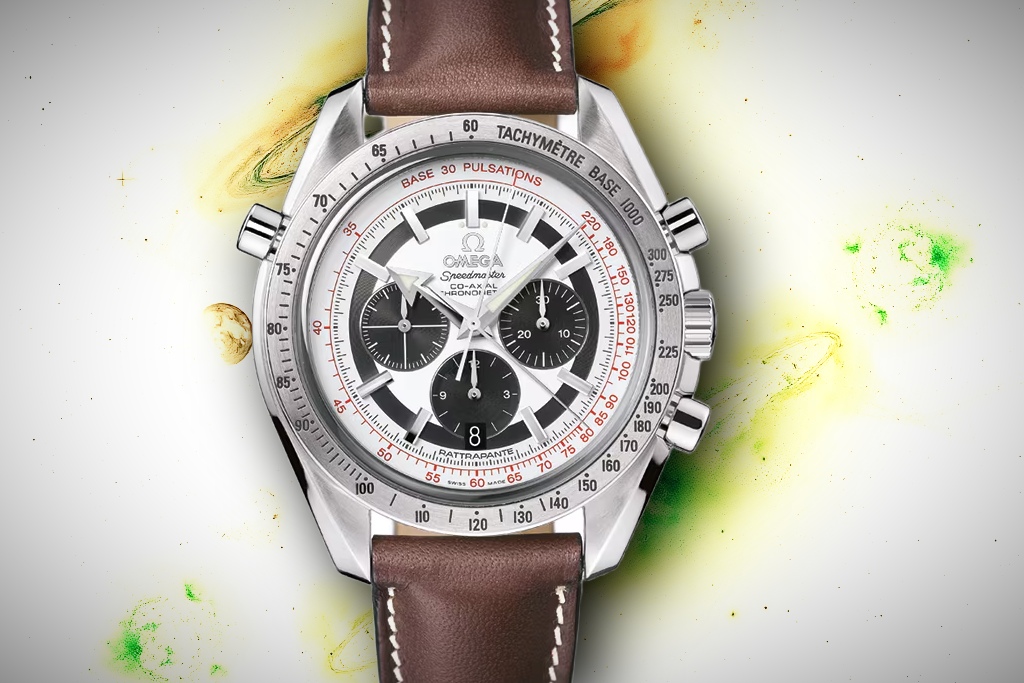
Inside the Omega Speedmaster Broad Arrow Co-Axial Rattrapante is the Omega Caliber 3612, based on the F. Piguet 1286 movement. It features Omega’s co-axial escapement, a column wheel, a date function. and like the GMT above, flyback functionality.
Neither of these 44.25mm Broad Arrows have a look that I would describe as “timeless,” but they’re both interesting luxury watches available under $5,000 secondhand nowadays. Because the dials are so big, and they have movements used on smaller chronographs, there was a lot of space at the edge of the dial to play with. On the split-seconds chrono, Omega filled it with a pulsometer scale (for measuring heartrate based on counting pulses) while the GMT has a prominent 24-hour track.
More on Omega:

Speedmaster Racing Master Chronometer (2017)
Omega has played around with various racing-themed aesthetics on the Speedmaster line, first with some Michael Schumacher editions in the early 2000s, and then with some 40mm co-axial Speedmaster Racing models that debuted in 2012 (more on those later). Then in 2017, Omega re-envisioned the Speedmaster Racing as a 44.25mm two-register model, available with a white dial or black dial.

Orange “Speedmaster” text and an orange chrono seconds tip are standard on both. The “racing” element comes from the alternating indentation of the quarter-second hash marks around the edge of the dial. It reminds me of a Seiko “rally bezel.” I think the main reason that the 44.25mm Omega Speedmaster Racing isn’t more popular–other than its $10,400 starting price–is its 14.92mm case thickness. The same could be said for almost all 44.25mm Omegas, really. Many collectors seem increasingly wary of watches thicker than 14mm.
List of All 44.25mm Omega Speedmasters with White Dials
| Name | Reference Numbers | Case | Details | Year Debuted |
|---|---|---|---|---|
| Speedmaster Broad Arrow Co-Axial Rattrapante | 3582.31.00 | Stainless steel | Split-seconds chronograph, panda dial | 2007 |
| Speedmaster Broad Arrow Co-Axial GMT | 3581.30.00 | Stainless steel | Cream dial, GMT function, date at 6 o’clock | 2007 |
| Speedmaster White Side of the Moon | 311.93.44.51.04.002 | White ceramic | Omega’s first white ceramic watch, crisp white dial, two subdials, date at 6 o’clock | 2015 |
| Speedmaster Racing Master Chronometer | 329.30.44.51.04.001 (bracelet), 329.32.44.51.04.001 (leather) | Stainless steel | White dial, orange and black accents | 2017 |
42mm Automatic Speedmasters with White Dials
Six 42mm Speedmaster Date models have been made with white dials. Like the 44.25mm models, they all have automatic movements and 6 o’clock date windows, and most of them are Broad Arrow models.
42mm Broad Arrow Speedmaster White Dials
Only a handful of Omega Speedmaster Broad Arrows have ever been made with white dials, and aside from the Speedy Pro Moonphase mentioned earlier, they’re all automatic date models. Each one is distinctive. In addition to the white 44.25mm Broad Arrow Speedmasters above, there are some 42mm options like a solid gold model (either yellow gold or white gold) with an enamel dial and painted Breguet-esque numerals, an Olympic commemorative model with an old-fashioned Omega logo, and one with attractive blued hands. Omega doesn’t seem to put white dials on just any normal Broad Arrow.
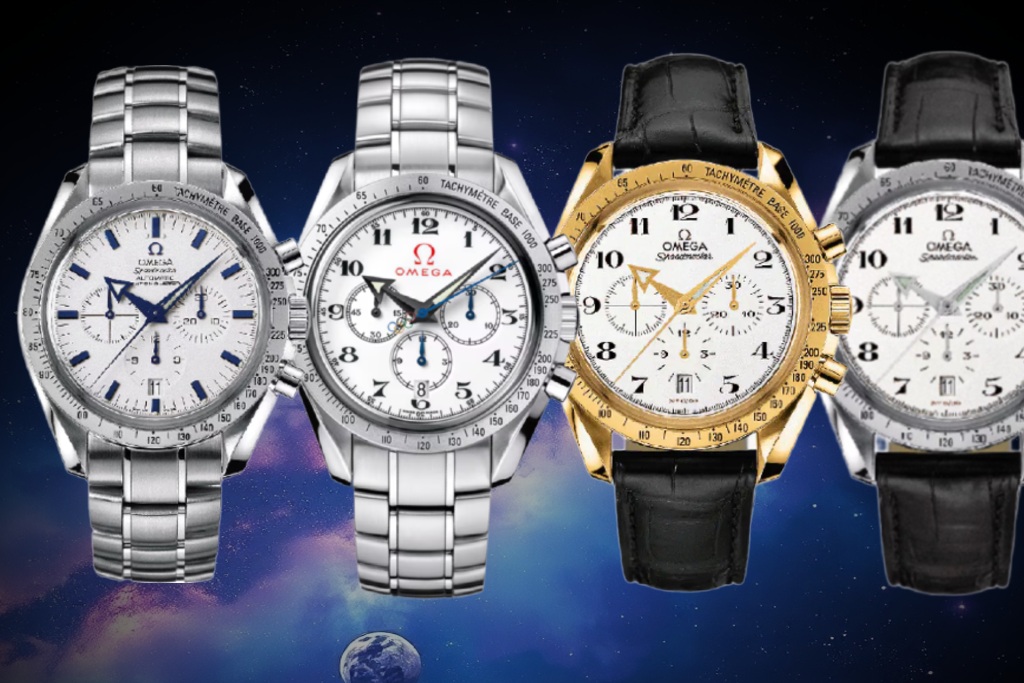
Only 198 gold enamel Broad Arrows were produced (half in yellow gold, half in white gold) and they sell for about $12,500 today.
Steel Broad Arrows are closer to half that. For my money, ref. 3551.20.00 is one of the coolest Speedmaster choices in the $6,000 pre-owned ballpark.
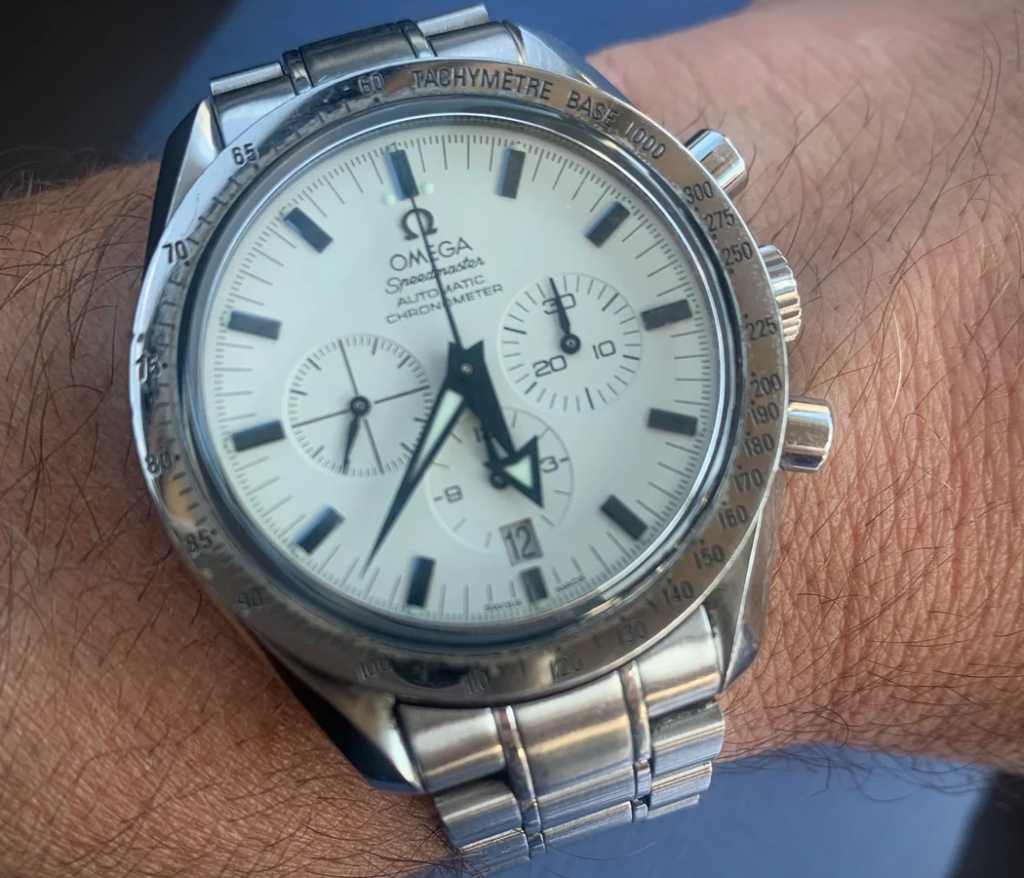
Schumacher Legend Edition (2003)
The only two automatic non-Broad Arrow 42mm Omega Speedmasters with white dials are “Schumacher Legend” editions from 2003-2004. These watches commemorated Michael Schumacher’s 6th and 7th Formula One world championships, respectively.

The white Schumacher Legend Edition shown above could best be described as an “eggshell panda” dial, and its black and red accents make comparisons to the Rolex Paul Newman Daytona inevitable. It was limited to 6,000 pieces in honor of his 6th championship in 2003, and there are also black and red versions produced in the same numbers.
A non-limited version with white hash marks and black subdial rings (instead of fully black subdials) came one year later along with Schumacher’s 7th world title. Schumacher Legend watches all have black date wheels and the Omega 3301 automatic chronometer movement.
All 42mm Omega Speedmaster Date Models with White Dials
| Name | Reference Numbers | Case | Details | Year Debuted |
|---|---|---|---|---|
| Speedmaster Broad Arrow Date | 3551.20.00 | Stainless steel | Blue hands, auto, creamy white dial | 2002 |
| Speedmaster Broad Arrow Date Enamel | 3656.20.31 (yellow gold) 3657.20.31 (white gold) | 18k gold | Crisp white enamel dial, Breguet numerals, 18k white or yellow gold case | 2002 |
| Speedmaster Schumacher Legend Eggshell Panda | 3559.32.00 | Stainless steel | Paul Newman-style panda dial | 2003 |
| Speedmaster Schumacher Legend White/Black | 3506.31.00 | Stainless steel | White dial with black chapter ring and subdial rings | 2004 |
| Speedmaster Broad Arrow Olympic Rings | 321.10.42.50.04.001 | Stainless steel | Multicolor Olympic logo as counterweight, historic-style Omega logo, Breguet-like numerals, crisp white dial, date at 6 o’clock | 2008 |
Speedmaster ’57 Titanium White (41.5mm)
The Speedmaster Heritage ’57 family, which debuted in 2013 with a 41.5mm width and a two-counter layout, is the successor to the earlier Broad Arrow models. Note that first-generation Speedmaster ’57 models only have the famous Broad Arrow hand for the chronograph hours indicator. There was only one Speedmaster ’57 made with a white dial, and like the popular earlier Omega Speedmaster Broad Arrows with white dials, it has blued hands–in addition to a titanium case.
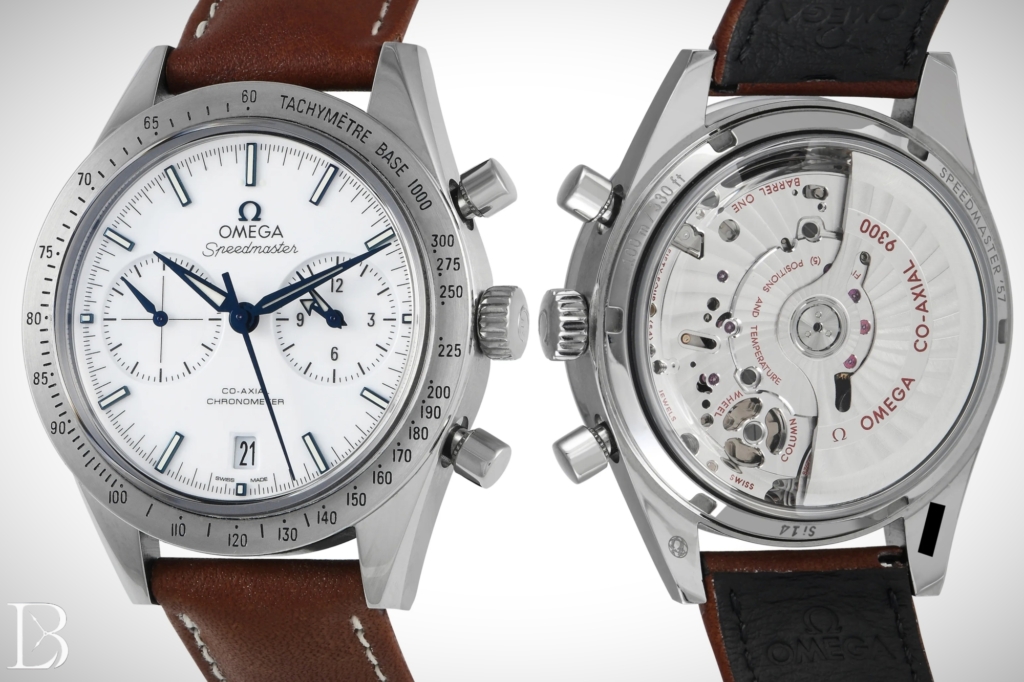
Omega has only ever made a few titanium Speedmasters, most of them being part of the quartz digital X-33 series. The current Speedy ’57 lineup (which has no white dial option) has returned the big arrow to its rightful place as the primary hour hand.
41.5mm Omega Speedmaster White Dial
| Name | Reference Numbers | Case | Details | Year Debuted |
|---|---|---|---|---|
| Speedmaster ’57 Titanium White | 331.90.42.51.04.001 (bracelet), 331.92.42.51.04.001 (strap) | Titanium | Lacquered white dial, blue accents, titanium | 2013 |
Speedmaster Date 40mm
39mm Speedmaster Date models were given the 6-9-12 subdial layout and 3 o’clock date that almost all ETA/Valjoux 7750-based chronos have, and the very first Speedmaster Date 40mm models that debuted in 2008 kept that configuration for a year or two.
Speedy Date 40 Olympic
The first Omega Speedmaster Date 40 with a white dial was Ref. 323.10.40.40.04.001, made to celebrate the 2008 Olympics.
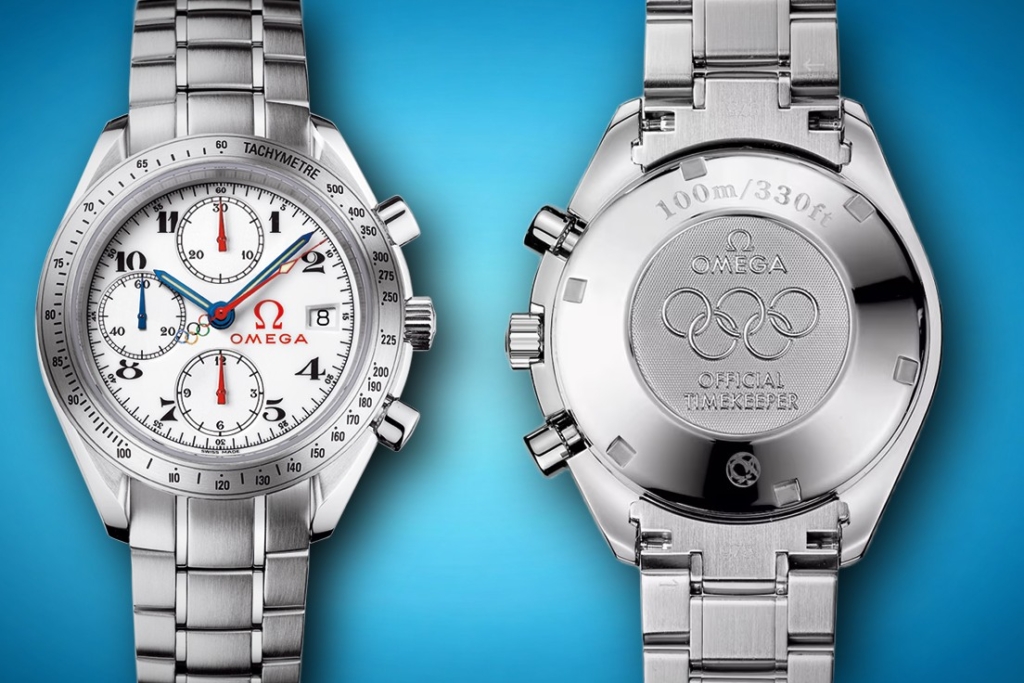
Speedy Date 40 Panda
But Omega would soon switch to a more classic 3-6-9 dial layout, with the date at 4:30, resulting in models like ref. 323.30.40.40.04.001:

There was also a Japan-only release similar to the watch shown above, but with “1957” on the dial and a black date window. It was released in 2009 and limited to 2,009 pieces.
Speedmaster Racing Co-Axial 40mm
The Omega Speedmaster Racing Co-Axial Chronograph models replaced the Date 40 in 2012. Racing models got the caliber 3330, which has upgrades like a column wheel, silicon hairspring and co-axial escapement.
The date moved to 6 o’clock, and the bottom subdial was shrunken to be smaller than the other two–a somewhat polarizing design choice. Only one 40mm Omega Speedmaster Racing was made with a white dial, and it’s a panda dial with yellow accents:
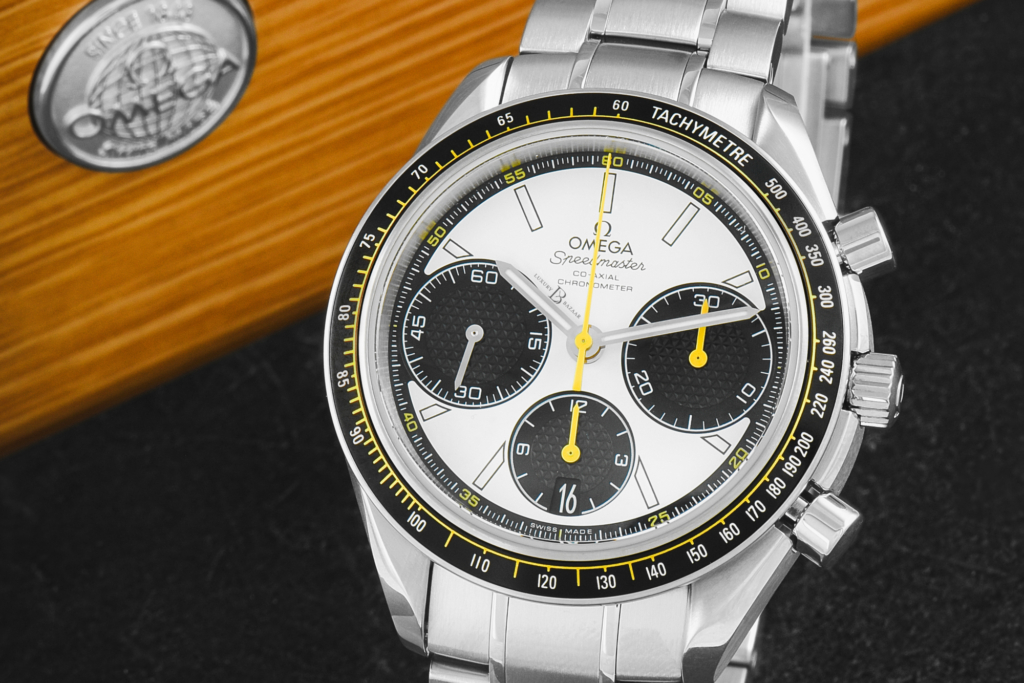
Now here’s a breakdown of all five white-dial 40mm Speedmaster reference numbers.
All 40mm Omega Speedmaster References with White Dials
| Name/Descriptor | Reference Numbers | Case | Key Details / Notes | Year Debuted |
|---|---|---|---|---|
| Speedmaster Date 40 Olympic | 323.10.40.40.04.001 | Stainless steel | White dial, red/blue hands, “Olympic Date,” true 40mm case, ETA 7750 movement and 6-9-12 subdials | 2008 |
| Speedmaster Date 40 Panda | 323.30.40.40.04.001 | Stainless steel | Panda dial, red accents, cal. 3304 COSC, 3-6-9 layout and 4:30 date | 2009 |
| Speedmaster Date 40 “Japan Panda” | 323.30.40.40.02.001 | Stainless steel | As above but with “1957” on the dial and a black date window, limited to 2,009 pieces, Japan only | 2009 |
| Speedmaster Racing (Yellow Accents) | 326.30.40.50.04.001 (bracelet), 326.32.40.50.04.001 (rubber) | Stainless steel | White dial, black Clous de Paris subdials, yellow accents, auto, date | 2017 |
Speedmaster Automatic 39mm
Although Omega has made automatic Speedmasters in numerous sizes, the term “Speedmaster Automatic” in everyday watch discussion is often used as a synonym for “Speedmaster Reduced,” which refers to any 39mm automatic no-date Speedmaster. But Omega also made some 39mm Speedies with dates, and even full calendars.
Speedy Reduced Albino (1988)
The very first white Omega Speedmaster, though, was a simple Speedmaster Reduced. While the black version of the Speedy Reduced has Arabic numerals marking 5-minute intervals (50, 55, 60 etc.), the Albino version does not. It sports a black aluminum bezel insert.
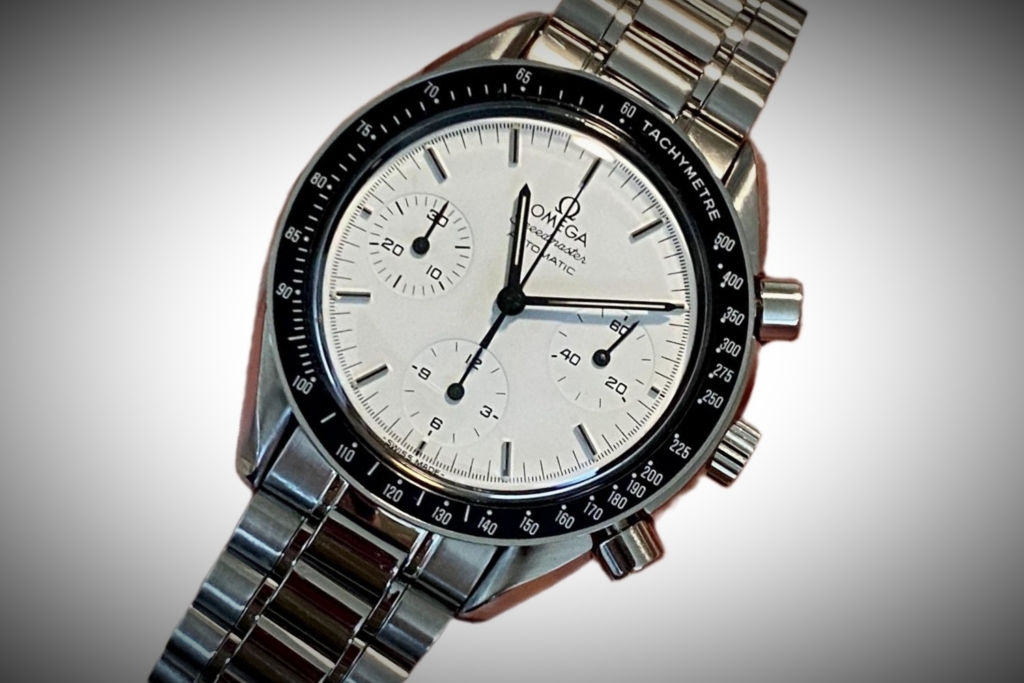
The Speedmaster Reduced Albino was available in stainless steel or two-tone. Note that sapphire crystals were phased in throughout the 39mm Speedmaster lineup in the 1990s. Models that start with 37 or 38 (like 3810.20 and its gold equivalent, ref. 3810W) have sapphire crystals while all earlier white Speedy Reduced models have the classic hesalite. Speedy Reduced models have the Speedy Pro-like 3-6-9 subdial layout, but 39mm date/calendar models all have 6-9-12 subdials. Let’s talk about those now.
Speedmaster Classic a.k.a. Triple Calendar (1993)
The Omega Speedmaster Classic, or more often the “Speedmaster Triple Calendar” to collectors, has a 39mm case as well. It was offered in steel, two-tone, or solid yellow gold. White dials were available in all three configurations. In fact, white was the only option for two-tone or gold models.

The Speedy Classic is an interesting part of Omega history, being unusually dressy for the Speedmaster lineup.
Speedy Date 39mm Albino (1993)
The Speedmaster Classic uses a pointer hand for its date function, but the first white Omega Speedmaster with a typical date window also hit shelves in 1993. It has a plain white dial, but unlike the Speedy Reduced Albino, which has a black insert, the 39mm Date Albino has a steel bezel.
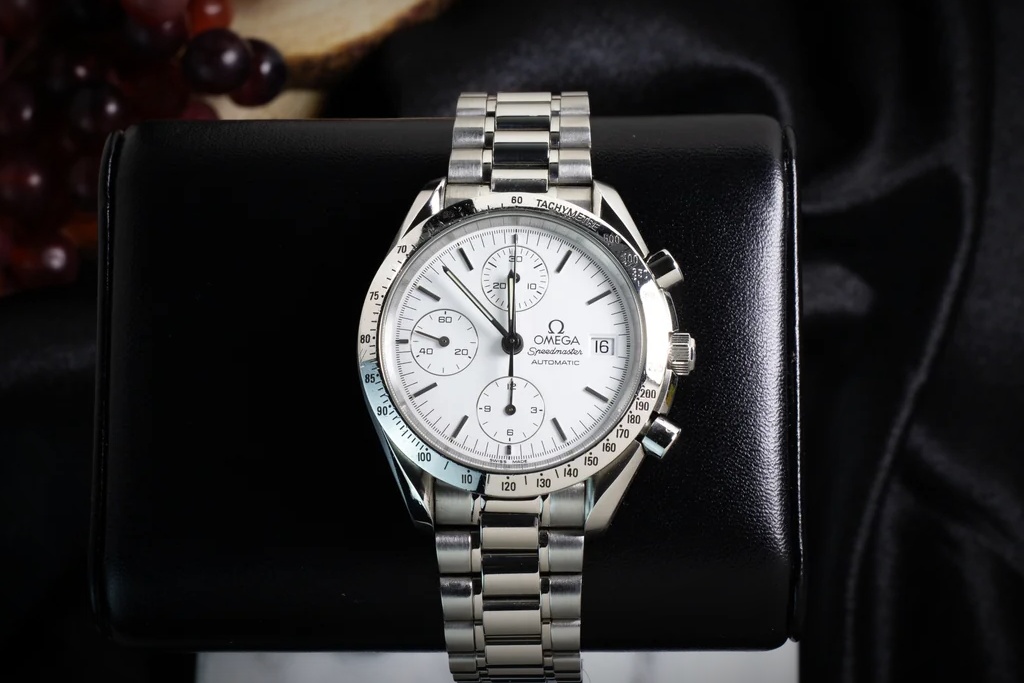
White Mark 40 (1995)
The interesting so-called “Mark 40” Speedmaster often gets confused for a Date 40 model because of its nickname, but it’s a 39mm date model. The white Mark 40 model appeared first in 1995 with red accents and an interesting guilloche pattern in the center of the dial. The steel version was given a black aluminum bezel insert while the two-tone version has a solid gold bezel.
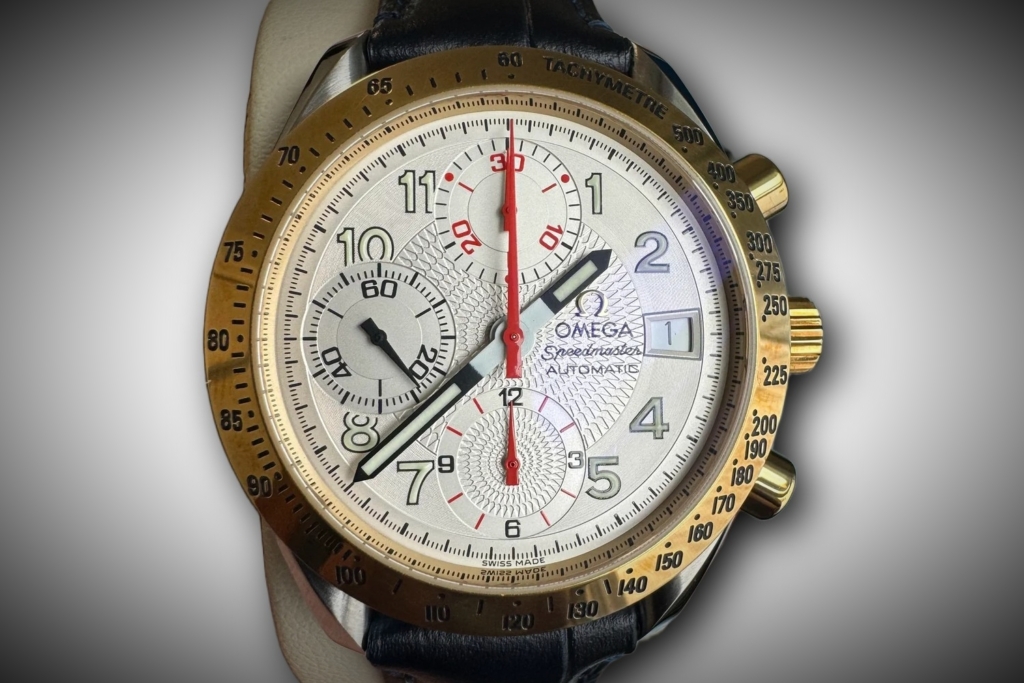
Speedmaster Reduced Marui Panda (1999)
In 1999, Omega released their first of two limited runs of Speedmaster Reduced models with panda dials exclusive to the Marui department store in Japan. The “Marui Panda” has a black aluminum bezel insert, and numerical 5-minute markings like the common black Speedy Reduced. The original Marui panda (ref. 3510.21) has a hesalite crystal, while its early-2000s successor (ref. 3539.31) has sapphire.
Olympic Speedy Date 39mm (2004)
There’s an Olympic 39mm Speedmaster Date model with a similar aesthetic to the 42mm and 40mm ones shown earlier. It pays homage to the 1932 Los Angeles Olympics.
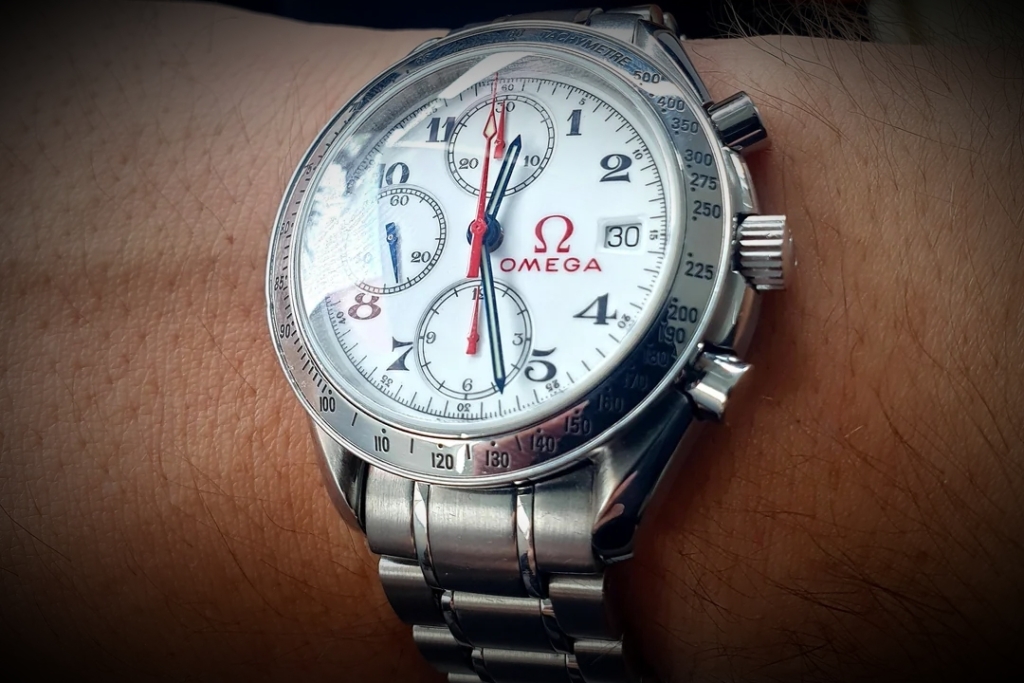
All Omega Speedmaster 39mm Models with White Dials
| Name/Descriptor | Reference Numbers | Case | Key Details / Notes | Year Debuted | |
|---|---|---|---|---|---|
| Speedmaster Reduced Albino | ST 175.0032, ST 375.0032, 3510.20, 3810.20 (sapphire crystal) DA 175.0032, DA 375.0032, 3310.20, 3810W (sapphire crystal) | Stainless steel or Two-tone | Plain white dials and black aluminum bezel inserts | 1988 | |
| Speedmaster Reduced w/Solid Gold Bezel | DA 175.0033, 3311.20, 3714.20 (sapphire crystal) | Two-tone | Solid gold bezel, some have plain dials while others have gold subdials | 1988 | |
| Speedmaster Classic (Triple Calendar) | 3523.30 DA 175.0034, DA 175.0038, 3336.20 BA 175.0034, BA 175.0038 | Stainless steel or Two-tone or Yellow gold | White dial, triple date moonphase | 1993 | |
| Speedmaster Date Albino | 3511.20, 3811.20 (sapphire crystal) 3711.20 (sapphire crystal) 3611.20, 3614.50.10 (sapphire crystal) | Stainless steel or Two-tone or Yellow gold | Solid metal bezel, date at 3 o’clock, 6-9-12 subdial layout, plain white dial | 1993 | |
| Speedmaster Date Mark 40 | 3513.33.00 (steel) 3313.33.00 (steel/YG) | Stainless steel or Two-tone | White dial with guilloche pattern, Arabic numerals, red accents, black aluminum bezel insert | 1995 | |
| Speedmaster Reduced Marui | 3510.21, 3539.31 (sapphire crystal) | Stainless steel | Sold exclusively at Japanese department store Marui, panda dial | 1999 | |
| Speedmaster Date 1932 LA Olympics | 3513.20.00 | Stainless steel | Fancy painted Arabic numerals, old red Omega logo, trapezoidal date window | 2004 |
Omega Speedmaster 38mm Models with White Dials
The first generation of 38mm Speedmaster Date models appeared in 2010, powered by the Omega Caliber 3304, a cam-actuated automatic chronograph based on the tried-and-true ETA/Valjoux 7753. Then it was updated in 2017 and given the name “Speedmaster 38,” along with the aforementioned upgraded column-wheel chronograph based on the ETA A08.L01 known as the Omega Caliber 3330.
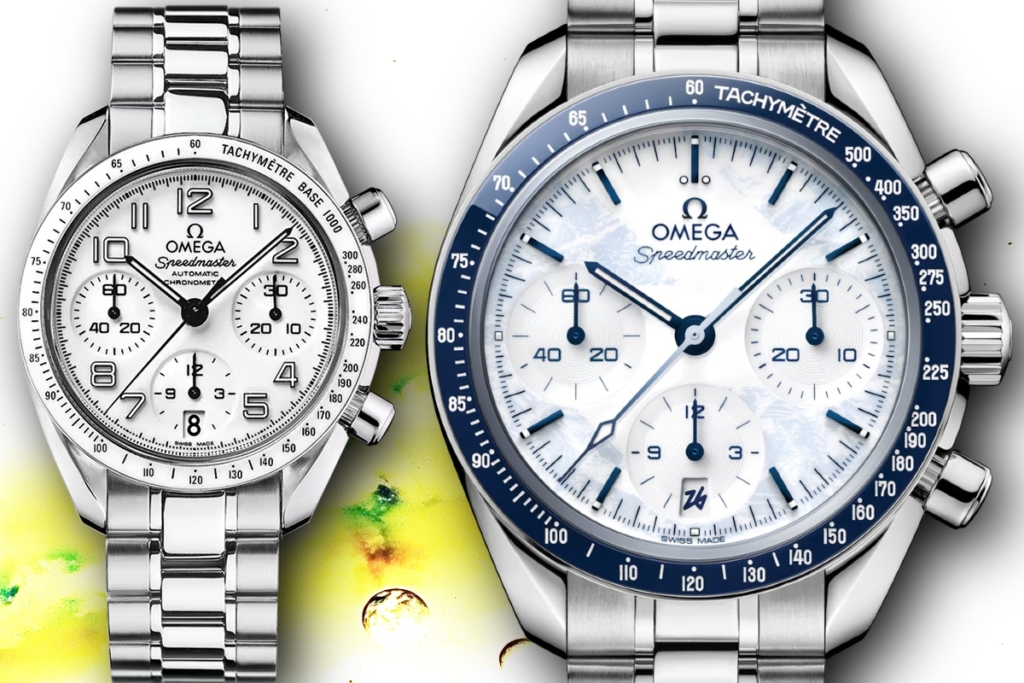
The 38mm Speedmaster Date ref. 324.30.38.40.04.001 sports not only a bright white dial with bright white Arabic numerals but a white ceramic bezel insert as well. And the Omega Speedmaster 38 Milano Cortina, featuring a white dial with some pleasant faint blue accents, is one of the 2025 Omega releases that celebrates the upcoming Olympic Winter Games. It also has a ceramic insert, this time in navy blue. The “26” on its date wheel has the same typography as the official Milano Cortina 2026 Winter Olympics logo.
The Milano Cortina Speedy 38 is a special edition, but not a limited edition, with an initial list price of $6,800. Most Speedmaster 38 models have weird oval subdials, but mercifully, this version has normal circular subdials.
38mm White-Dial Speedmasters
| Name/Descriptor | Reference Numbers | Case / Materials | Key Details / Notes | Year Debuted |
|---|---|---|---|---|
| Speedmaster Date 38mm White Arabic | 324.30.38.40.04.001 | Stainless steel | White ceramic bezel insert, white Arabic numerals | 2010 |
| Speedmaster 38 Milano Cortina | 522.30.38.50.04.001 | Stainless steel | Blue ceramic bezel insert, light blue dial accents | 2025 |
That should cover every Omega Speedmaster with a white dial. Omega has never made a white-dial Speedmaster in 39.7mm (the size of the First Omega in Space), 40.5mm (second-generation Speedmaster ’57), 43mm (modern two-counter Speedmaster), or 45mm (X-33) sizes to my knowledge. But of course, if I’ve forgotten any, let me know in the comments!


